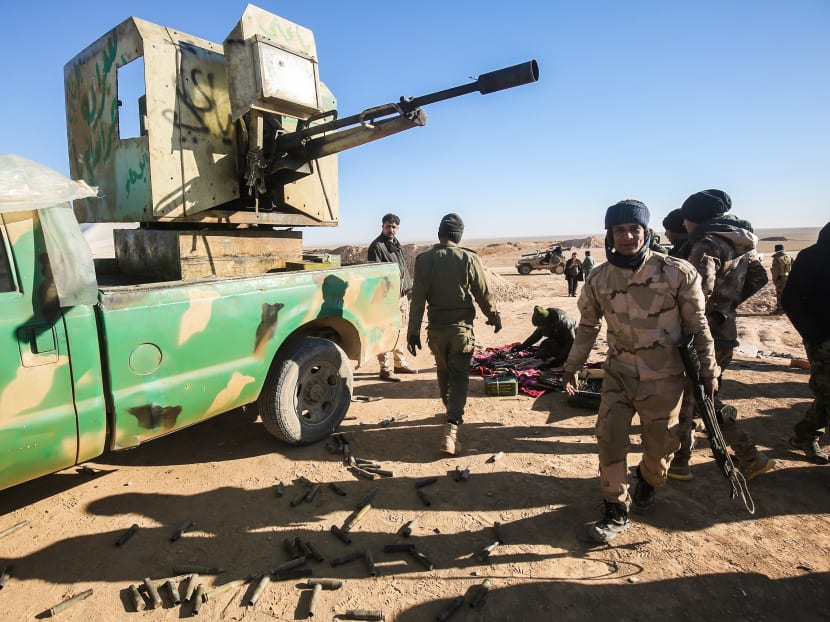350,000 children trapped in West Mosul
LONDON/ARBIL (IRAQ) — The first four months of the Iraqi offensive on Mosul were marked by relatively low displacement but the civilians who remain in the city’s west face more dangers than ever.

Fighters of the Hashed al-Shaabi (Popular Mobilisation) paramilitaries prepare defensive positions near the frontline village of Ayn al-Hisan, on the outskirts of Tal Afar west of Mosul, where Iraqi forces are preparing for the offensive retake the western side of Mosul from Islamic State (IS) group fighters. Photo: AFP.
LONDON/ARBIL (IRAQ) — The first four months of the Iraqi offensive on Mosul were marked by relatively low displacement but the civilians who remain in the city’s west face more dangers than ever.
Some 350,000 children are trapped in western Mosul, charity group Save the Children warned on Sunday (Feb 19) as Iraqi forces launched an offensive on jihadists in the city.
“Iraqi forces and their allies, including the US and UK, must do everything in their power to protect children and their families from harm, and avoid civilian buildings like schools and hospitals as they push deeper into the city,” said the London-based charity’s Iraq country director, Mr Maurizio Crivallero.
He warned that escape is not an option for most families, who risk summary execution by fighters from the Islamic State group, sniper fire and landmines — but they are also running out of food, water and medicine.
"This is the grim choice for children in western Mosul right now: bombs, crossfire and hunger if they stay — or execution and snipers if they try to run," Mr Crivallero said in a statement.
He added: "Safe escape routes for civilians must also be established as soon as possible."
In the east, the Iraqi forces adopted a strategy of protecting civilians by keeping them at home, and the mass exodus expected by humanitarian organisations did not occur.
Since the Mosul offensive against the Islamic State group was launched in October, around 200,000 civilians are estimated to have fled their homes, and some 50,000 have already returned, according to the United Nations.
In the early stages of the offensive, the army dropped tens of thousands of leaflets into Mosul, some bearing safety instructions for residents, most of whom remained in the city.
This prevented both sides from resorting to heavier weapons, avoiding large-scale destruction, as was the case in the battles of Fallujah and Ramadi.
“We know that IS targets people who try to flee, causing many casualties,” Abdulwahab al-Saadi, a top commander of the elite Counter-Terrorism Service that did most of the fighting, told AFP.
“Of course it would be easier for us to bomb the jihadists with heavy weapons if the city was emptied of its inhabitants, but as our main goal is to preserve the lives of civilians, we are convinced they will be better protected if they stay at home rather than try to flee,” he said, stressing this strategy had been a “success” in the east.
It is a strategy that has been endorsed by some, including Mr Hazem Ghanam, a 58-year-old resident who was in east Mosul during the battle.
“It’s a good plan, it worked for us in the eastern side,” he said.
Although he is worried about a brother and two nieces who live in the west, Mr Ghanam said it is better to stay put.
“Even though God spared some, the people who tried to flee got hurt. It’s better to stay home.”
But 19-year-old Mr Taha Ahmed thinks those who can should leave the city, as he did with his family after two months of brutal fighting. “We escaped at 2am. There were a lot of families with us. IS was shooting at us but we kept running,” he said.
“I would tell the people (on the western side) if there is heavy shelling they should hide at home in a safe place. And if they have a chance to get out, it’s better to flee.”
It took Iraq’s most seasoned forces — the CTS — more than three months of heavy fighting to retake the left bank of the Tigris River that divides Mosul.
Taking back the city’s west bank promises to be even tougher, as the narrow streets of the Old City will be impassable for many military vehicles and force government fighters to take on IS in dangerous dismounted warfare.
Ms Lise Grande, UN humanitarian coordinator in Iraq, said it remains to be seen if security forces are able to spare the lives of civilians in the latest assault.
“The Iraqi security forces were able to protect hundreds of thousands of civilians in eastern Mosul” and “their intention is to use a similar humanitarian concept of operations in western Mosul,” she said.
“If it develops that the army cannot protect civilians, then other arrangements will be made. That could include helping families cross the front line... (and) opening humanitarian corridors.”
No official figures are available on the number of deaths during the offensive in the east.
But the government of the autonomous region of Iraqi Kurdistan said 14,000 wounded civilians and soldiers had been admitted to hospitals in Arbil since the start of operations on October 17. AFP






